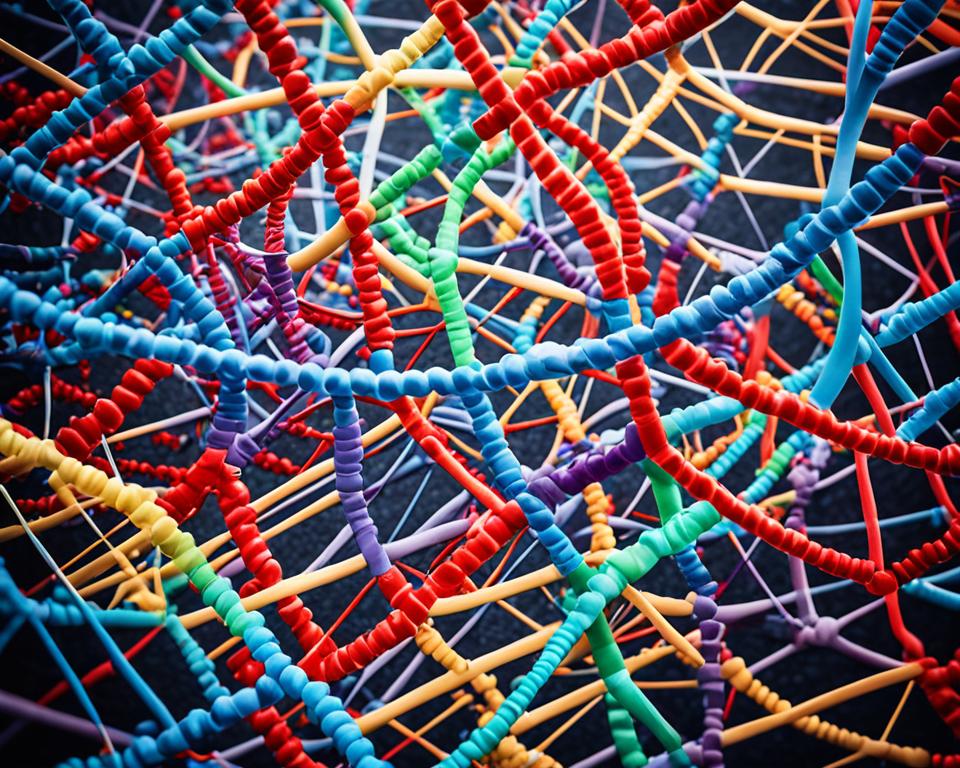It's crucial to know that students with autism and ADHD need special study strategies. Autism…

Autism Genetics: If My Husband Has Autism, Will My Child?
For families where autism in family is a topic of discussion, the web of autism and heredity may hold a blend of concern and curiosity. The complexities of autism spectrum disorder in children are evident, as ASD can manifest in many different ways, from social communication challenges to unique behavioral patterns. Notwithstanding, the heart of autism and parenting revolves around love, understanding, and the pursuit of knowledge to navigate potential hereditary paths.
With a narrative woven by both research and real-life accounts, the genetic tapestry of ASD underscores a pattern – a likelihood that might nudge the odds higher for children when a parent, especially a father, is on the spectrum. But what does this mean for expecting parents or those planning to start a family? It’s a puzzle of genetics, probabilities, and the vital role of early intervention.
The conversation around risk factors and genetic transmission is far from over, but it’s tinged with hopeful hues of proactive strategies and supportive resources. It’s about paving a path illuminated by awareness and backed by science for the benefit of our children’s future.
Key Takeaways
- ASD can run in families, indicating a significant genetic component to its prevalence.
- Understanding the family history of ASD is key for early screening and intervention.
- Autism is more common in males, but genetic risks remain pertinent for all children.
- Genetic counseling and testing might offer insights into a child’s risk for ASD.
- Parenting with awareness around autism can lead to improved management and support for children potentially on the spectrum.
Understanding Autism Spectrum Disorder and Inheritance
As one delves into the intricacies of Autism Spectrum Disorder (ASD), it becomes evident that the condition extends well beyond just behavioral patterns. It touches the very fabric of a family’s genetic tapestry. With a concern for autism and genetic predisposition, many families are keen to explore the genetic link to autism and its potential impact on future generations.
What is Autism Spectrum Disorder?
Autism Spectrum Disorder is a complex developmental condition marked by challenges with social interaction, communication, and often characterized by repetitive behaviors. Symptoms can typically be noticed from a young age, often presenting before the age of three. Recognizing the subtle tell-tale signs, such as difficulties with eye contact and processing social cues, is critical for early intervention.
Genetic Link to Autism: How It’s Transferred Between Generations
While research continues to unravel the exact causes of ASD, the prevailing consensus points towards a strong genetic influence. A child with a parent or sibling on the autism spectrum may face a heightened risk due to this genetic predisposition. Discoveries in genetic studies suggest heritability rates for ASD could range from 40 to 80 percent, indicating that the condition often runs in families. This genetic fabric is not woven from a single thread but rather a complex intermingling of multiple genes, making the act of inheritance a varied and complex process.
The Importance of Family Health History in Autism
Understanding autism risks for offspring calls for a thorough examination of a family’s medical history. This history should be as comprehensive as possible, covering not only immediate relatives but also previous generations. It’s essential to record any instances of developmental disorders, even those that might not have been formally diagnosed, offering invaluable insights for future generations. A well-documented family health history can serve as a roadmap for healthcare professionals to provide personalized monitoring and support for children who may be at risk, thereby improving outcomes for affected individuals.
If My Husband Has Autism Will My Child: Assessing the Risks

Within the sphere of family life, the presence of autism brings about a series of critical questions concerning heredity and the future wellbeing of children. Autism and parenting are intricately linked, with implications for families that extend well beyond genetics. Particularly in situations where a husband is on the autism spectrum, couples commonly confront uncertainties regarding their child’s likelihood of being affected by autism spectrum disorder (ASD).
Research underscores that autism in family contexts does indeed present a heightened risk for offspring. Parents with a child already diagnosed with ASD face a substantial chance a risk that heightens with the presence of multiple children with ASD or if the affected child is a girl. It’s imperative to understand that while genetics are a central element, with various gene variations playing a contributing role, they do not solely dictate the outcome.
- The likelihood of having a second child with ASD can be as high as 18% for parents.
- Risks are amplified if the existing child with ASD is female or if there are additional family members with ASD.
Genetic testing serves as a beacon, shedding light on potential autism and heredity connections. Conditions such as fragile X syndrome and Rett syndrome are of particular interest and can pave the way for targeted interventions and strategies.
We see from ongoing studies the intricate mix of maternal and paternal genetic factors involved in ASD, highlighting the occasional paternal influence, particularly with rare gene variants. However, it is also crucial to appreciate the complexities involved, as a direct inheritance pattern is not always present.
In the context of autism spectrum disorder in children, recognizing the shared genetic components is valuable, yet it is equally important to remember that not all children of parents with ASD will inherit the condition. Genetics, while influential, are part of a broader spectrum of interacting factors that influence the expression of ASD.
In closing, the journey of autism and parenting is nuanced and requires a holistic view of each unique situation. Awareness and attentive observation can aid in providing the best possible environment for all children, irrespective of their genetic inheritance, embodying the adaptability and resilience that is so often necessary in family dynamics.
Conclusion
In wrapping up this discussion on the inheritability of autism, it is clear that a link exists between autism in family members and the genetic predisposition for autism spectrum disorder in children. It is necessary to acknowledge that while the presence of autism and heredity factors increase the risk, they do not sole-handedly predetermine the likelihood of a child being on the spectrum. Current knowledge indicates a significant connection, guiding parents in understanding autism risks for offspring and the steps they can take towards effective parenting and advocacy.
Key Takeaways on Autism and Genetic Predisposition
Armed with insights into the complexities of autism and genetic predisposition, families can better navigate the prospects of autism spectrum disorder in children. Key takeaways emphasize the crucial role family health history plays in gauging potential risks and the value of early detection in managing autism and parenting. Reflecting on the heightened risk for children with a familial pattern of ASD, the pursuit of genetic counseling and thorough health documentation stands out as a proactive measure.
Parenting Strategies for Children with Autism Spectrum Disorder
For those who are charting the waters of parenting a child with ASD, it becomes essential to foster strategies that support growth and development. Embracing a nurturing approach while educating oneself on autism’s nuances can create a positive impact. Customized parenting tactics, informed by professional guidance, can lead to more engaging and supportive environments for children with ASD.
Encouraging Early Intervention and Support for Better Outcomes
Early intervention emerges as a cornerstone in achieving more positive outcomes for children affected by ASD. As such, parents are encouraged to seek early support and intervention services, which are instrumental in addressing developmental challenges promptly and effectively. Engaging healthcare professionals to comprehend the unique circumstances of their family can lead to tailored strategies, ensuring that children with ASD receive the comprehensive care and support they deserve.
FAQs
What is Autism Spectrum Disorder?
Autism Spectrum Disorder (ASD) is a developmental disorder that affects communication and behavior. It encompasses a broad range of conditions characterized by challenges with social skills, repetitive behaviors, and difficulty with speech and nonverbal communication. Symptoms usually appear in the early years of life.
Is there a genetic link to autism?
Yes, there is a genetic link to autism. Studies show that autism can run in families, and having a relative with ASD increases the likelihood of a child being on the autism spectrum. Genes play a complex role, with certain genetic mutations associated with autism.
How is autism transferred between generations?
Autism can be transferred between generations through genes. While the exact inheritability of ASD is complex, if a parent, sibling, or another first-degree relative has ASD, the risk for other family members to have ASD is higher. Both maternal and paternal genes are thought to play a role, and sometimes rare genetic variants may be involved.
Why is family health history important in autism?
Family health history is important in autism because it can provide clues about the genetic risks for ASD. Knowing whether there are relatives with ASD or related genetic conditions can help to identify individuals at increased risk for autism, allowing for early intervention and appropriate support services.
If my husband has autism, what are the chances my child will too?
The chances of a child having autism increase if a parent has ASD. Although it’s not a certainty, there’s a genetic predisposition that can affect the likelihood. Each family’s situation is unique, and factors such as the presence of autism in siblings and the extent of the condition in the family can play a role.
What are the risks of autism in families where one member has the condition?
In families where one member has ASD, the risk of another family member being affected can be higher than in the general population. If one child has ASD, the risk of having another child with ASD can be around 18%, and it increases if there are multiple children with ASD in the family or if the affected child is female.
Can genetic testing help with understanding the risk of autism?
Genetic testing can help in understanding the risk and potential causes of autism, especially if there’s a known genetic condition like fragile X syndrome in the family. It can provide information about genetic factors contributing to ASD and guide treatment and intervention strategies.
What parenting strategies can help children with Autism Spectrum Disorder?
Parenting strategies that can help include creating a structured environment, maintaining a routine, using visual aids, engaging in play that promotes social interaction, and advocating for therapies tailored to the child’s needs. It’s also important for parents to seek support and education on ASD to better assist their children.
How can early intervention and support improve outcomes for children with autism?
Early intervention and support can significantly improve the outcomes for children with autism by addressing developmental delays, enhancing social and communication skills, and providing strategies to manage behavioral challenges. Tailored therapies and educational programs initiated at a young age can lead to better long-term development and adaptability.



This Post Has 0 Comments